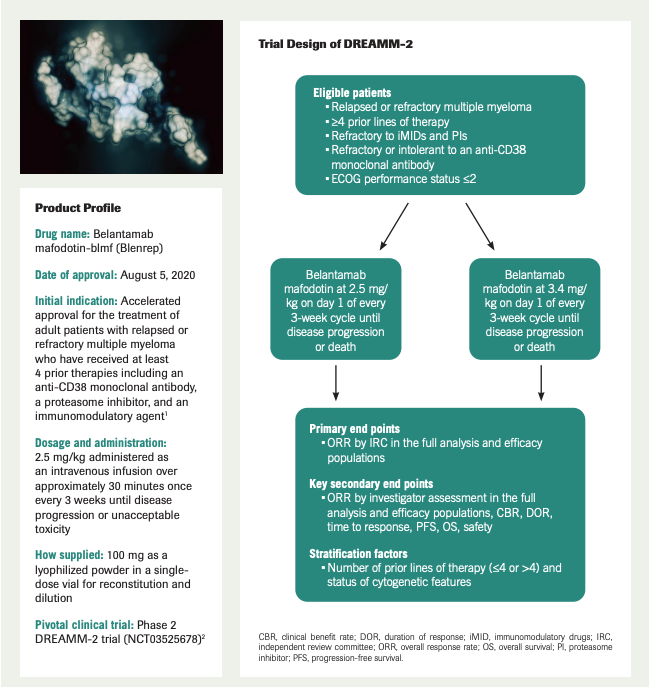Expert Commentary on The Product Profile of Belantamab Mafodotin
Kathryn Maples, PharmD, BCOP, discusses real-world implications of belantamab mafodotin in patients with pretreated multiple myeloma.
Maples is a Clinical Pharmacy Specialist of Multiple Myeloma at the Winship Cancer Institute of Emory Healthcare in Atlanta, GA.

ONCOLOGY®: Can you briefly describe the mechanism of action of belantamab mafodotin?
Maples: Belantamab mafodotin [bela-maf] is a first-in-class, novel antibody-drug conjugate. It is an antibody targeting BCMA [B-cell maturation antigen], which is expressed on multiple myeloma cells. The antibody-drug conjugate has a payload of monomethyl auristatin F, which is more like our traditional cytotoxic chemotherapy [drugs]. The antibody component binds to the BCMA expressed on the myeloma cells. The whole antibody conjugate is taken into the cell, where the payload is then released to cause the cell death, so it helps deliver more of that cytotoxic chemotherapy into just those BCMA-targeted cells.
Q: What are some of the biggest concerns with the toxicity profile of bela-maf? Have any new safety concerns become more apparent with its use in the real-world treatment setting?
Maples: The top 3 grade 3/4 adverse effects that we saw in the clinical trials were keratopathy (changes to the cornea), thrombocytopenia, and anemia. Those are the top 3 adverse effects that we’re seeing in clinical practice, as well. The most important thing to know, and especially [to discuss with] patients, is the [possibility of] keratopathy. Some patients will have symptomatic eye toxicity: blurry vision, dry eyes, or changes in their vision. Many patients will not have symptoms, but they’ll have those cornea changes on exam. That’s an important [distinction] to make to the patients, because they’re not used to having their treatment held. Patients [with myeloma], especially at this stage in the game, have been on therapy for many, many years and are used to it. With bela-maf, we’re having to dose, then hold, and dose, then hold, because of the keratopathy. [It’s important to] explain to them that they may not have any symptoms, but what the eye doctor is seeing on their eyes is resulting in the dose being held. What we’ve seen in clinical practice has been consistent with what we saw on the clinical trials, and we are seeing that [with the use of] dose holds and dose reductions, these symptoms are resolving. And most commonly, I would say we’re seeing them occur around cycle 2 or cycle 3.
Beyond the eye toxicity, we most commonly see thrombocytopenia and anemia, especially in these heavily pretreated patients, so [management involves] utilizing platelet transfusions and blood transfusions, as needed.
Q: Do you recommend that all patients who are on this drug be monitored by an eye care professional?
Maples: That’s actually a requirement for the REMS [Risk Evaluation and Mitigation Strategy] program. In the clinical trials, the eye care professional had to be an ophthalmologist, but with the FDA approval, it can be any eye care professional. The patient will see this eye care professional for a baseline exam, prior to starting [bela-maf], and then they will see them every 3 weeks, prior to every single dose. It’s a good thing to educate the patients on, because it’s going to be 1 more doctor visit that they will have to have every 3 weeks, to make sure that we’re following the REMS program and having their eyes checked. They will see those eye doctors very frequently, and we work very closely with them for any additional medications that they may need for their eye toxicity.
Q: Should patients and providers know about any additional aspects of the REMS program, beyond the close eye monitoring?
Maples: The REMS program has 3 key players. First, the providers have to enroll, and they will take an assessment quiz as part of their enrollment. But then they can assign delegates, so that could be their [physician assistant, nurse practitioner], or it could be their clinical pharmacists. I have been assigned as a delegate for my providers. Those are going to be the people who are assessing what the eye doctor tells us.
The eye doctor fills out a form that grades the patient’s vision changes as well as their keratopathy changes. We input these data into the REMS program [to determine] if the patient can continue therapy. The patient also has to enroll, so we do that initially as part of their patient education.
The third component, which is important for infusion pharmacists and nurses to be aware of, is the infusion center, which also has to be enrolled in the REMS program. They have the final component, called the REMS checklist; once the drug is given, they sign off on the exact milligram dose that was given, and the day that it was given.
The eye doctors are not enrolled, but they’re a key player. Making sure that you have all 3 of those things set up before you get your first patient going is very critical.
Q: Are dosing modifications common with this agent?
Maples: If the patient experiences a grade 2 toxicity—be it visual acuity changes or keratopathy—the recommendation is to hold [the dose] until they return to grade 1. At that point, you can resume at the 2.5-mg/kg dosing. However, if a patient experiences grade 3 toxicity, then the recommendation is to again hold until they return to grade 1. At that point, you would reduce down to a 1.9-mg/kg dose. Based on of the grade of the toxicity, we’re always going to be holding, but the difference between grade 2 and grade 3 is [that the latter] requires a dose reduction.
Q: Should clinicians be aware of any major drug interactions?
Maples: Luckily, with this medication, there are not many significant drug interactions. Of course, [we’d like] to avoid any other medications that cause eye toxicity. As this is an antibody-based medication, we don’t have many significant drug interactions to worry about.
Q: Have any barriers to administration or receipt by the patient emerged since this agent’s approval, such as common reimbursement issues or logistical challenges to obtaining the medication?
Maples: The biggest barrier is the REMS program. While it exists for a necessary reason and it’s very doable, it is a cumbersome thing to get started, just to make sure that everything is in alignment. Our biggest barrier was making sure that we had everything set up at the infusion center before we could even get the drug delivered. If your institution, like mine, has multiple infusion sites, they may each have to be registered individually, so only 1 of ours is currently registered. Something for patients to keep in mind is that even if they’re used to getting treatment at one place, they may have to get it somewhere else just based upon the requirements there.
In terms of reimbursement, the patients who we are putting on this medication have more than those 4 prior therapies, so just being mindful of the type of patient who you’re initiating on this therapy will reduce any issues with getting reimbursement.
[You should] think about getting the eye appointment scheduled [for the patient]. This is not a therapy that you can decide on today and start treatment tomorrow. It will take at least a week or so to get set up, so that’s something for the patient and the team to keep in mind.
Financial Disclosure: The authors have no significant financial interest in or other relationship with the manufacturer of any product or provider of any service mentioned in this article.

REFERENCES
FDA granted accelerated approval to belantamab mafodotin-blmf for multiple myeloma. FDA. Updated August 6, 2020. Accessed April 19, 2021. https://bit.ly/3dyY2ns
Lonial S, Lee HC, Badros A, et al. Belantamab mafodotin for relapsed or refractory multiple myeloma (DREAMM-2): a two-arm, randomised, open-label, phase 2 study. Lancet Oncol. 2020;21(2):207-221. doi:10.1016/S1470-2045(19)30788-0

Implementing a Multidisciplinary Lifestyle Medicine Clinic for Cancer Survivorship
The lifestyle medicine needs of cancer survivors seeking lifestyle consultation are growing, and awareness of the benefits of lifestyle medicine for this population can enhance the quality of life for patients who are survivors of cancer.